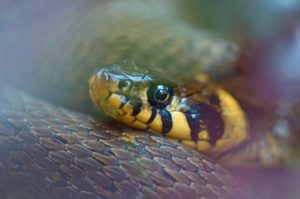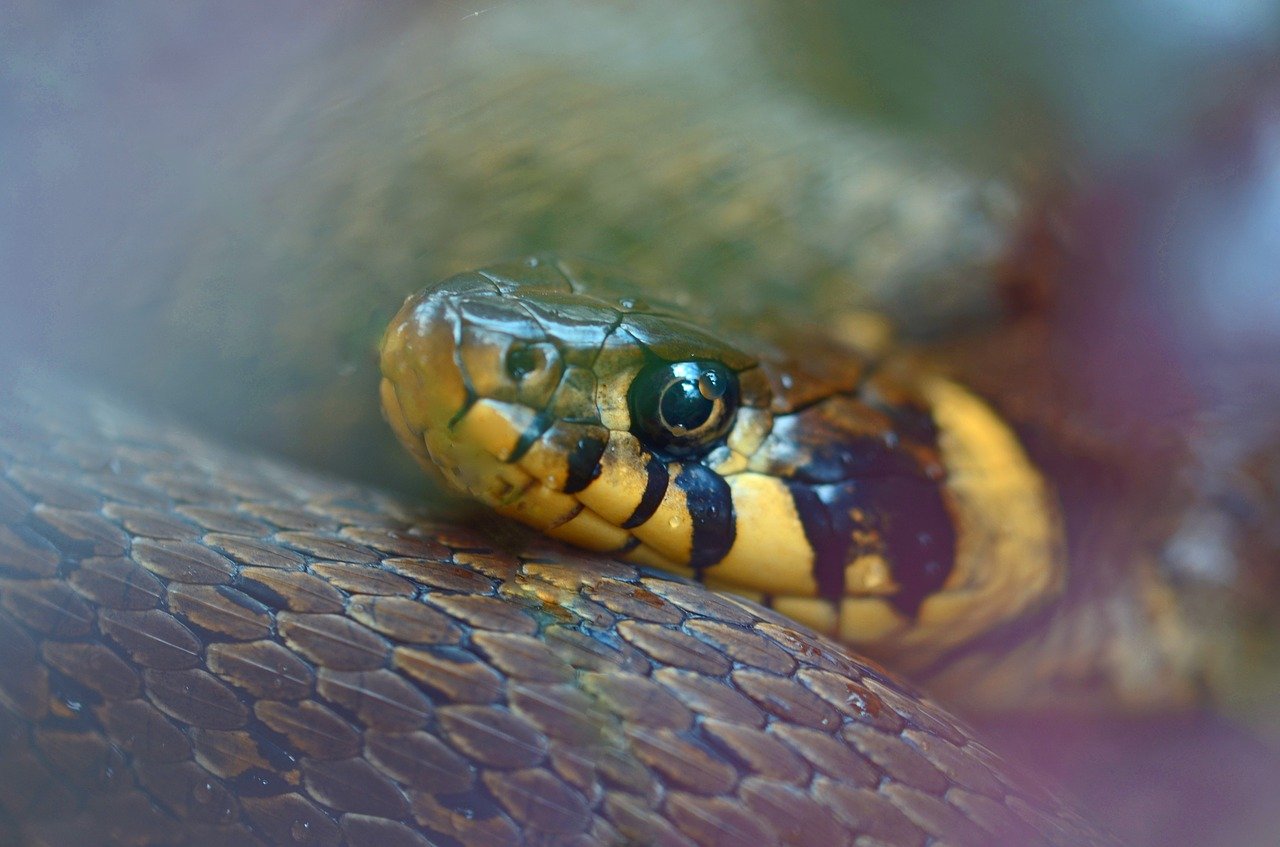He didn’t want to go out; he never went out at night. The night was when they came slithering, he knew, those cursed snakes. God help me.
Mark Anglewood walked briskly—as fast as his old bones permitted—down the narrow footpath, holding his torch out before him, his heart pounding. He tried his best not to focus on anything he saw or heard for too long—the bushes to his left and right, the chirping of crickets, the twigs and rotten sticks on the ground, anything—lest the twigs turn to cobras and the cricket songs to rattlesnake calls.
The things we do for love, eh?
He would have killed to be back in his living room, watching the evening news as always, his wife Addie with him, her head to his chest and their two ginger kittens on their laps. But his wife had come down with a fever all of a sudden, and they were out of drugs.
“Could you help me get some pills from Sharla at the pharmacy, hon?” Addie asked.
“It’s night time,” Mark complained, not wanting to go. “She probably won’t be there by now.”
“Just go check on her. Please.” She put a hand to her head and winced. “I feel like my head’s about to explode.”
If he were the sick one, he would have much preferred to sit and toil in pain till morning. But it was Addie. He couldn’t bear to see her so down.
They lived in a forested patch of land, and the path from their house to the main road was a narrow dirt road, surrounded by trees and greens.
And snakes.
Though he was yet to encounter one, he always wore his hard leather boots just in case. He never liked living in a forest, but his wife loved nature and always wanted to be surrounded by it. Mark ended up succumbing to her wishes. The things we do for love, eh?
He accepted her wishes, but he wasn’t going to leave there without necessary precautions. In his ten years of living there, he had never seen a snake eye to eye. Not because there weren’t any, no—the neighbours see them every time—but because he made sure to avoid any and everything that would make him cross paths with one. He never went out at night, he didn’t make friends with crazy people (those snake-loving cretins), he always traveled with cars, his entire house was walled with snake fences, and the bush was cut back several meters. I’ll have no snakes on my lawn.
How Did Mark Anglewood Develop Phobia for Snakes?
As he walked, he would kick away any stick or rope or coil of wire he saw on the road. They looked too much like the reptile he never wanted to see again. The last time he saw a snake was the first time he saw one, sixty years ago when he was seven. He and his father were about to go cycling and Mark had gone to the garage to look for a pump to reflate his bicycle tire when he saw a rock python resting behind a stack of boxes. Before then, He had only seen a snake on documentaries before then, and none of them were as big as the one he saw.
He didn’t scream. He just stood there, unable to move, unable to look away from those deathly eyes.
His father came ten minutes later when he noticed he wasn’t coming out. Ten minutes was all it took to scar him for life. The wildlife control eventually came to take the snake away, but they couldn’t take away the memories.
He remembered how terrified he was that night; how he couldn’t stand, how he couldn’t go anywhere alone, how he couldn’t sleep, how every shadow in the house became a lair for snakes, how every rope and wire and coil would start slithering when he looked too long…
He shook away the thoughts.
Ever since, any mention of a snake or the sight of one in a photo or video would send him into a panic attack. Several times he would hope to God to never see a snake again till he died, and as he continued to climb in age, it seemed his wish was coming true. So why did his wife have to fall sick at night of all times?
Further down was the pharmacy…
The leaves and prickles on the bushes around him were so close they brushed his arms as he walked. There could be snakes about them and I would be none the wiser. When had they grown so much? He would have cut them down much sooner if his bones hadn’t turned to paper with age.
The footpath led to a grassy clearing, dotted with trees and patches of shrubs. Further down was the pharmacy. Thank heavens they weren’t closed. After purchasing the drugs, he thanked Sharla and headed back home. The night was chilly, and the cold was seeping through his sweater. He trudged down the footpath, darting his torch from one random movement to the next, his old eyes wide open.
He saw a brown rope lying a few feet off the footpath and he got startled. Then He shone his torch at it better and saw that it was a skipping rope. Damn those children, he thought. He would always tell them not to leave their playthings lying around when they were done but they would only listen half the time. He went over to kick it further away into the bush.
Oops 😬🤭…
As he was just about kicking, the skipping rope shot up at him. The bite would have dug into his leg had he not been wearing the leather boots.
Mark leapt a yard or two away. The puff adder retracted almost instantly after striking. It hissed and coiled back into a defensive stance. Mark felt his bones shiver. Dear God, it’s a snake. His heart went into overdrive. He always imagined he would run faster than an Olympic athlete the next time he saw a snake, but when he stared at this one, the torch glinting off its eyes, he froze yet again.
A snake. His body started trembling. He wanted to run the other way and scream like a little girl, but he could have been carrying the whole world on his head with how impossible it was to move.
A snake. He stared with terror in his eyes, his breathing heavy, his heart beating so hard it felt like it would explode.
I’m going to die, he thought. I’m going to die I’m going to die I’m going to die…
Then he felt a crushing tightness in his left chest. He dropped both torch and drug to grabbed his chest as the heavy feeling rose within him. Slowly, he dropped to one knee, groaning, his breathing turning into long hollow rasps as he tried to suck in all the air in the world but only managed a wheeze.
His face met the soft earth, his eyes shutting ever so slowly as his consciousness left him. Even now, he still wouldn’t stop looking at the snake. Like with the python, all he could do was stare at its demonic grey eyes.
OPHIDIOPHOBIA
Mark Anglewood struggled with one thing: his fear of snakes. Ophidiophobia (the fear of snakes) is one of many phobias that people experience all around the world. It is a subclass of herpetophobia (the fear of reptiles) that about a third of the world’s adult human population face, making it the most common reported phobia.
In a 2013 study, it was found that the human brain is evolutionarily conditioned to be afraid of snakes and snake-like forms, since they have been a threat to humans for several thousands of years.
This means that most people have some degree of fear for snakes. However, for certain individuals the fear runs far deeper than a simple cautious evolutionarily ingrained response to threat. In such individuals, the fear is so extreme that it starts to interfere with their lives and well-being.
NOTE: The statement above can be simply interpreted as; not all individuals who have the fear of snakes are ophidiophobic.
Causes of Ophidiophobia
Like other phobias, the reasons for certain individuals having a strong fear for snakes are several and may be a combination of multiple factors, which altogether turn this innate fear into something that induces panic and anxiety in the victim. Some of the causes are:
1. Traumatic Experience
Having a traumatic encounter with a snake, especially while young, can be a reason for ophidiophobia. Perhaps the victim was bitten or nearly killed by one, or perhaps they found themselves stuck in a place with it for a long time. Such scarring experiences leave marks, and often cause triggers in the victim later in life.
2. Learned Behaviours
A person might learn to fear and avoid snakes after witnessing a close relative show fear at the sight of one. It is rooted in the human adaptive response, to pick up cues and learn about threats from the experiences of others.
3. Media Portrayal
In many ways, this is a subsection of learned behaviour. The media is a powerful tool, and the effects can be seen in how it is able to induce certain fears in individuals who might probably not have had such fears otherwise. The fear of spiders in many western countries, for example, is in part due to the constant portrayal of movie characters being afraid of spiders, or due to films like “Arachnophobia” (1990, directed by Frank Marshall) showing spiders in a terrifying light.
This is true for snakes, being portrayed in movies like the “Anaconda” series (1997, 2004, 2008) as massive, bloodthirsty creatures that devour humans like mice. While this isn’t the true nature of snakes, the damage done to the audience is irrevocable, and many struggle to so much as look at pictures of snakes after watching such films.
Symptoms of Ophidiophobia
Like in several other phobias, the symptoms may include:
- Panic attacks; Experiencing a feeling of intense fear when simply thinking about snakes without being physically near them.
Doing everything in their power to avoid places or situations where they might find snakes. - Sweating.
- Breathing difficulty.
- Tightness in the chest.
- Nausea.
- Diarrhoea.
- Hot flashes or chills.
- Dryness of the mouth.
- Sense of confusion or disorientation.
- Paralysis (inability to move due to shock and extreme fear)
- Dizziness or lightheadedness.
- Tachycardia (increased heart rate, which in severe cases could escalate to sudden cardiac arrest, like in Mark’s situation.)
- Tremors (they experience shaking, shivering, trembling of arms, or palms or any other part of the body.)
- Paresthesia (a burning or prickling sensation usually felt in your arms, hands, legs, or feet.)
Symptoms may worsen depending on the situation, whether the victim is alone with the snake, the proximity of the victim to the snake etc.
Diagnosis of Ophidiophobia
Ophidiophobia is treated as an anxiety disorder. It is diagnosed as a specific phobia, which means an intense fear or anxiety in response to a specific trigger, such as an animal, environment, or situation.
Treatment of Ophidiophobia
There is no single treatment for a specific phobia like ophidiophobia, and in some individuals, it is impossible to get rid of. However, some common treatment methods for ophidiophobia include:
1. Exposure Therapy
Systematic desensitization of an individual by exposing them to their fear in a nonthreatening environment is a means of combating specific phobias like ophidiophobia.
This may be in the form of victims looking at images or videos of snakes, and analyzing their emotions and reactions along with their therapist.
A natural escalation to this is to use virtual reality, where the individual is experiencing seeing and being around a snake in a digital medium, with the advantage of not having to face an actual live snake.
This could then progress to observing a live snake from a distance, preferably in protective gear while in a controlled environment. Perhaps a snake handler would be around should anything go awry.
A test of complete treatment might be to physically touch or carry a snake—probably a non-venomous boa—without experiencing symptoms of anxiety.
2. Cognitive Behavioral Therapy
This attempts to change the victim’s pattern of thinking regarding the object of their fear. Cognitive behavior therapy generally involves hands-on problem solving that helps change the way the victims feel about the issue.
This might involve talking to herpetologists (someone who studies snakes) to learn more about the animals or visiting snake owners to understand their reason for liking them.
3. Medication
Sedatives and beta-blockers can be used to treat the phobia. It is often accompanied with talk therapy. Beta-blockers help slow the heartbeat should the victim experience panic. This can help them feel calm and relaxed.
Sedatives calm the nerves, but may lead to dependence. Thus, they are often discouraged by many prescribers who instead advise counseling and other safer methods.
CONCLUSION
A fear of snakes is a common truth for most individuals, and while it is a lot stronger in people with ophidiophobia, it all simply boils down to one fact; it’s a fear, and fears can be overcome. And while it might be difficult to stand in the face of one’s fear (or for people like Mark, it is difficult not to stand), what matters is that they continue to try to better themselves, and hope that one day, they can stand before their fear, not due to paralysis, but because finally they can say, “You don’t scare me.”

Writer: Ameen Ahmad Opeyemi
University of Ilorin, Kwara State, Nigeria .
Ameen Ahmad Opeyemi is a 200L Medical Student from the University of Ilorin, Ilorin Kwara State. He enjoys playing games—just one, really, Clash of Clans—reading science fiction and fantasy novels and watching similar movies.



My God… Seeing that snake scared me. I literally had to cover the image with my hand while scrolling through.
I have a question… I saw those methods of treatment. But I can’t get myself to even consider being treated. How does one even go about it.
Because I don’t think it’s easy for someone with a phobia to just start treating it by looking at photos.
Anyways, thanks for this. It was very informative. The fact that I read it is a feat on its own. Thank you